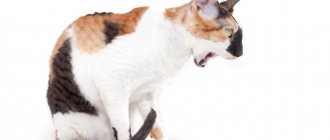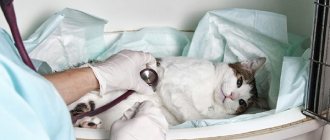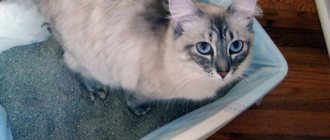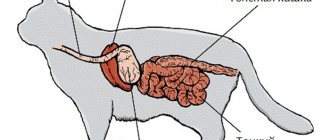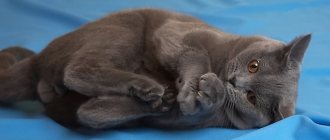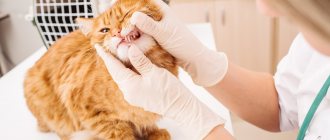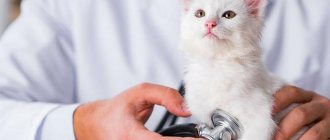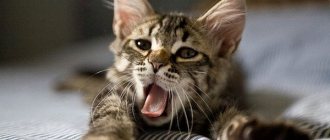Jacobs ulcer
This defect most often affects the upper lips of the purr, although in rare cases such a sore can form on the lower lip or directly in the mouth. Jacobs' ulcer in cats is a disease of predominantly purebred individuals, who have weaker immunity and genotype in comparison with their domestic relatives. Some sources also call the above disease eosinophilic ulcer or eosinophilic granuloma. Jacobs ulcer is considered a precancerous condition of the skin. Without timely and proper treatment, the above ailment often develops into fibroma or sarcoma.
Causes
To date, scientists have not come to a final decision as to what exactly - allergies, parasites, viruses or genetic predisposition - causes Jacobs ulcer.
However, there are six factors that influence the acceleration of the development of this disease.
- Poor nutrition.
- Feeding poor quality food.
- Recent bacterial or viral illnesses.
- Exhaustion of the cat's body.
- Cachexia.
- The cat's predisposition to allergic reactions.
Symptoms
A small reddish spot appears on your furry pet’s lip, most often on the upper lip, which over time can turn into a huge stinking eczema. In this case, the cat will not feel pain or even basic itching. If you start treatment, then in the future you can observe ulceration of the foul-smelling spot, as well as its deepening. The cat will begin to suffer from pain, the animal will lose its appetite and become lethargic. This stage of the disease has dubious prospects for healing.
Treatment of Jacobs ulcer
If a veterinarian accurately diagnoses this type of ulcer, pets are treated for approximately three weeks with corticosteroids - Sulfetrim, Prednisolone or Depo-Medrol. True, the above remedies will be very effective only in the early stages of Jacobs ulcer. “Patching” holes in the cheeks will have to be done exclusively by surgical methods.
Injuries
Cats are very curious: even a pet that has no chance of getting outside can find adventure in its face while exploring the apartment. A small wound (for example, when trying to bite a cactus - this happens!) will most likely heal quickly. However, for some time a small sore or ulcer will be noticeable in its place.
An animal may become interested in the stove or heater that has just been turned off, and get burned: the burn also leaves a mark in the form of a sore.
You might be interested in: Why does a cat constantly tuck its tail between its legs?
Corneal ulcer
A corneal ulcer in a cat is always a consequence of trauma or other damage to the eyes, as well as the development of certain infections.
Healthy eye after corneal ulcer
Types of corneal ulcers in cats and their signs
There are purulent and perforated corneal ulcers.
Symptoms of a purulent ulcer
- Photophobia.
- Severe pain.
- Corneal defects of various shapes and sizes.
- Discharge of mucopurulent fluid from the eye.
- Blepharospasm.
- Vascularization.
- Clouding of the edges of ulcers.
- Swelling at the edges of ulcers.
Symptoms of a perforated ulcer
- Part of the cornea has a gray-blue tone.
- The iris most often falls out in the center.
- Mixed vascularization is observed.
Corneal ulcers are fraught not only with scars, but also with macula, leukoma or nubecula.
Treatment of corneal ulcers
All cats with rapidly progressing corneal ulcers must be hospitalized. Aibolit puts a special collar on the purr so that the animal cannot damage its eyes.
Antibiotics in the form of ointments are lubricated into the conjunctival sac 2-4 times a day. Solutions are instilled every 3-6 hours. Tobramycin, Gentamicin, Chloramphenicol and Terramycin may be prescribed.
The drug Acetylcysteine, which is instilled into the cat's sore eye on average every 3 hours, has good anti-collagenolytic characteristics.
Aspirin is an excellent pain reliever and relieves inflammation. Cats are given it after 48 hours at 10 mg/kg.
To protect the cornea from irrigation, reduce pain, and prevent leakage of medications, contact lenses may be prescribed to a sick cat.
Each type of treatment for a corneal ulcer should be prescribed exclusively by a qualified veterinarian, since the use of most medications has some contraindications.
Superficial ulcers are predominantly treated with conservative methods.
Surgeries are inevitable for descemetocele, as well as ulcers whose size exceeds 50% of the thickness of the cornea. All operations are fraught with possible serious complications, including complete blindness, therefore caring cat owners are strictly contraindicated to delay contacting veterinary clinics when the first pathological symptoms are detected.
Preventing stomach problems
The primary thing is proper nutrition and a balanced diet, varied food rich in vitamins and minerals. Give your cat only high-quality food, taking into account the breed, weight, age and individual characteristics of the body.
Do not use low-quality budget food, do not feed your pet human food and bones, which can injure the digestive tract and lead to serious health problems.
Hide household chemicals and anything that can cause poisoning away. Don’t be lazy to take your cat for a preventive examination and tests if he has reached old age.
The optimal food temperature for a cat is room temperature, so do not give it frozen or hot foods. Keep an eye on their freshness and quality.
The article is of a recommendatory nature. Consult your veterinarian!
Stomach ulcers
There are two types of stomach ulcers.
- Simple gastric ulcers in cats with an irregular shape and relatively good healing
- Peptic ulcers with a round shape and thick edges.
Causes
This disease occurs quite often in cats, since there are many reasons for its occurrence.
- Various wounds, injuries and other damage to the gastric mucosa, for example, a purr may accidentally swallow a small bone or nail.
- Stress.
- Poisoning.
- Long-term feeding with cheap dry food, such as Whiskas.
- Chronic pancreatitis.
Symptoms
It is difficult not to recognize a stomach ulcer, since any cat owner will see its signs.
- Weight loss.
- Loss of appetite.
- Vomit.
- Depressed state of the animal.
Treatment methods for stomach ulcers in cats
Having diagnosed a stomach ulcer in your furry pet, the veterinarian will prescribe sedatives, painkillers and antispasmodics, as well as drugs that protect the walls of the stomach and help speed up scarring.
But treatment of this disease cannot guarantee any effect without the use of diet therapy.
A recovering purr should be fed lukewarm and semi-liquid food - purees, soups and soufflés, 3-5 times a day. The veterinarian will most likely recommend one of the ready-made diets - Royal Canin, Ekanuba or Hills.
Symptoms of a problem in a cat
In veterinary medicine, it is customary to distinguish between acute and chronic forms of the disease. The chronic course of the disease is often asymptomatic; it is difficult for the owner to suspect the presence of a stomach ulcer in a pet. In the first phase of the development of the disease, the symptoms resemble a stomach disease such as gastritis. In the future, the picture of the pathology becomes more pronounced.
Clinical signs of the acute form of the disease are more pronounced and are characterized by the following symptoms:
- Lethargic, depressed state of the pet. The cat spends a lot of time sleeping and avoids active games. The characteristic pose of the animal is lying with its hind legs pulled up to its stomach.
- Decreased appetite in the chronic course of the disease, complete refusal to eat in the acute course.
- Frequent attacks of vomiting streaked with blood.
- Belching.
- Impaired production of hydrochloric acid and enzymes leads to the development of digestive problems. The cat has constipation and diarrhea mixed with blood.
- An unpleasant odor from the mouth is caused by impaired digestion of protein foods.
- When examining the mucous membranes, pallor is detected in the gum area. If liver disease is involved in the pathological process, yellowness of the mucous membranes and skin is observed.
- Severe pain in the abdominal area. The pet reacts negatively to touch and shows aggression.
- Unhealthy appearance: dull and matted coat, increased shedding.
- In advanced cases, the sick animal has tarry black stool due to digested blood from the stomach.
Veterinarians distinguish between simple and progressive ulcers. In the first case, the owner may experience a chronic course of the disease and periods of exacerbation when the clinical picture becomes pronounced. With a progressive ulcer, clinical signs increase.
When perforation of the stomach walls or intragastric bleeding occurs, the animal’s condition sharply worsens and pain shock is observed. The progressive form of the disease often leads to peritonitis, sepsis and death of the animal.
Indolent ulcer
Indolent, otherwise called eosinophilic, ulcers in cats are localized in most cases above the upper lip.
The early stages are manifested by small ulcers with a concave surface. As the above disease progresses, the size of the lesions increases and acquires a reddish-brown tint. In the future, such ulcers will be characterized by slightly raised edges, as well as ulcerated masses.
How to properly treat an indolent ulcer? Aibolit prescribes a course of glucocosteroids for the cat (this can be cyclosporine, prednisolone or similar drugs), as well as antibiotics (amoxicillin and clavulanic acid are most often prescribed).
Main symptoms of the disease
It is problematic to independently distinguish gastritis from gastric ulcer. The symptoms of these pathologies largely coincide, so to make an accurate diagnosis, we recommend contacting a veterinary clinic.
Among the symptoms indicating the development of a stomach ulcer:
- severe pain,
- vomiting with blood,
- rapid weight loss,
- oppression,
- lethargic state
- constipation,
- pallor of the mucous membranes,
- black chair,
- elevated temperature,
- specific odor from the mouth.
Note! When palpating the abdominal area, cats experience pain: they worry, moan, and meow loudly.
Owners will immediately notice changes in the pet’s behavior: it becomes very lethargic and apathetic, practically does not move, and stops playing and running. He lies down, rests and sleeps more. Refuses to eat and drinks a lot.
Ulcers on the tongue
An ulcer on the tongue in cats is one of the manifestations of calcivirosis. Calcivirosis is a feline viral disease that affects the respiratory system. The causative agent of this disease almost does not react to most disinfectants.
To prevent your cat from getting calcivirus, ventilate the room better and more often, vaccinate your furry pet against this disease in a timely manner, and also do not keep a large enough number of felines in the house.
Calcivirus is transmitted through direct contact by sneezing.
When cells affected by calcivirosis are destroyed, erosions and ulcers often form in the oral cavity and on the mucous membranes of the respiratory tract.
The cat, at the same time, refuses food, its body temperature can rise to 40C. The tongue, hard palate, lips and even the tip of the nose can be affected by ulcers.
Medicine does not have specific drugs against this bacterial infection. However, calcivirosis can be treated quite effectively in several ways.
- To prevent the development of a viral infection on a weakened cat’s body, antibiotics are prescribed.
- The antiviral immune response is stimulated using feline immunostimulants.
- Prevention of dehydration.
- Antipyretic drugs.
- Prescription of adaptogens and vitamins.
- Sanitation of the cat's oral cavity with Dentavidin, Miramistin, chamomile decoction or a weak solution of potassium permanganate.
Definition
As you know, an ulcer is a damage to the skin or mucous membrane that is difficult to heal or does not heal at all. Often such pathologies are associated with autoimmune diseases or cases where the body’s defense system practically does not function. Jacobs ulcer is one of the latter types. The mouth and lips are affected, but in severe cases, ulcers can appear on the cheeks and spread to other parts of the body, including even the stomach. Note that the pathology is relatively rare, and therefore lesions on your pet’s lips are probably explained by a more prosaic reason. But it still wouldn’t hurt to show him to the vet.
Interesting! In 97% of cases, the disease affects exclusively purebred cats. The more high-born the animal, the higher its chances of getting sick. This is due to the large number of gene mutations accumulated during selection. Outbred cats practically do not suffer from this disease.
Why is this ulcer dangerous? Firstly, constantly ulcerated areas of the skin and mucous membranes are “tidbits” for pathogenic microflora. Bactria quickly colonize these places, which is fraught with purulent inflammation and sepsis. Secondly, veterinarians have already proven for sure that Jacobs ulcer is fraught with the appearance of fibroids/sarcomas. These are extremely aggressive forms of cancer that are almost always fatal.
Cat treatment
Treatment of a cat with a stomach ulcer begins with making a diagnosis and eliminating the causes that led to the animal’s disease. Next, antispasmodics, painkillers, vitamins and minerals are prescribed. Good results are achieved by syrups/suspensions that envelop the walls of the stomach, thereby protecting them from the effects of hydrochloric acid, and also helping the mucous membrane to scar faster (the most famous and effective is Almagel A).
Without diet therapy, a positive effect cannot be achieved quickly. Therefore, you will have to completely reconsider your diet.
Nutritional Features
How to feed a cat with a stomach ulcer should be correct - it should go on a special diet.
- It is best to give rice porridge (together with a decoction, so that this gluten envelops the walls of the stomach - boil the rice well and do not get carried away with it alone, as it strongly strengthens
). - Give us slimy cereals, for example, oatmeal.
- Broths made from lean meat are very filling.
It is better not to give meat and fatty foods.
Also put aside hard-to-digest foods for later. Take care of your pet's stomach.
How to make a diagnosis
This dangerous disease can be diagnosed during a clinical examination. The absence of pain and itching also indicates the presence of a Jacobs ulcer. Immediately when the first sign appears (a red spot on the lip), a specialist may recommend a biopsy. To do this, a small piece of tissue is carefully cut from the affected area and a thorough microscopic examination is carried out. If a proliferation of eosinophilic cells is detected in the area of inflammation, a diagnosis of Jacobs' ulcer can be confidently made.
Important. A blood test in the case of such a pathology is not informative. In the blood, the number of eosinophils (leukocytes) will remain within normal limits. Whereas in the ulcer itself the level of their content will be simply enormous.
If a Jacobs ulcer is suspected, the veterinarian carefully examines a piece of affected tissue under a microscope.
In addition, if the animal has recently suffered a severe viral or bacterial disease, then this also indicates that the erosive wound formed on the lip is a Jacobs ulcer. Often the cause of the disease is a fungal infection, which is very difficult to treat and severely suppresses the body's immune system.
How is diagnosis carried out?
To identify pathology, the animal must undergo radiography.
At the first symptoms, you should immediately contact your veterinarian. The most informative procedure for stomach ulcers is considered to be radiography of the abdominal cavity using a contrast agent. Using an x-ray, a specialist will be able to determine ulcerations or perforation of an organ. It is also recommended to perform gastroscopy under anesthesia. In addition to these methods, diagnostic procedures are used, such as:
- stool occult blood test;
- general and biochemical blood tests;
- coagulogram;
- Ultrasound of the gastrointestinal tract;
- biopsy.
Treatment: which methods are effective?
Drug therapy
The drugs must be prescribed by a doctor. Self-medication can cause the death of the animal, since not all medications for people are useful for cats. A gastric ulcer requires complex treatment and includes the medications shown in the table:
| Pharmgroup | Name |
| Antispasmodics | "No-Shpa" |
| "Papaverine" | |
| "Spazgan" | |
| To reduce the production of hydrochloric acid | "Cimetidine" |
| "Omeprazole" | |
| "Ranitidine" | |
| Antiemetics | "Chlorpromazine" |
| "Metoclopramide" | |
| For mucosal protection and tissue regeneration | "Scopolamine" |
| "Almagel" | |
| "Methyluracil" | |
| Bismuth sucralfate | |
| Magnesium trisilicate | |
| Atropine sulfate | |
| Antibiotics | Appointed individually |
Things to remember
First of all, you need to know that Jacobs ulcer is just one type of pathology that leads to eosinophilic proliferation of connective tissue. After all, there are also eosinophilic plaques, milliary allergic dermatitis and eosinophilic granulomas.
Sometimes it happens that these lesions are combined in the body of one animal. Then Jacobs ulcers appear on the abdomen, cheeks or mouth, which is a sign of a complex eosinophilic lesion. All these ailments are treated in the same way, but when such ulcers grow and there is extensive damage to the cat’s body, it can be judged that the animal has a severe autoimmune disease.
Causes
Diseases of the intestines and stomach are common in animals, so they have been sufficiently studied regarding their causes, treatment, and prevention. There are several reasons why a cat may suffer from an ulcer attack or regular severe stomach pain:
- Ulcers are caused, as in humans, by taking medications . Sometimes treatment with medications cannot be avoided; in this case, it is necessary to protect the cat’s stomach and intestines from the harmful effects of taking it.
- Chronic, advanced gastritis, in which the gastric mucosa becomes inflamed also leads to the appearance of ulcers
- A sharp object, such as a bone, for example, can get into a cat’s digestive tract It injures tissue, mucous membranes, and can even cause bleeding. Even if you do without punctures, internal damage to the stomach still remains.
- Cats constantly lick their fur; it accumulates in balls in the stomach cavity, causing irritation and microtrauma, which is very dangerous.
- Ulcers also develop due to pathological processes in the internal organs. We are talking about pancreatitis, cirrhosis, kidney diseases. The cause of the disease can also be deviations in the functioning of the endocrine system. Oncological formations in the gastrointestinal tract also pose a danger.
- Poisoning with food, chemicals and also leads to the development of an ulcerative condition.
- Many diseases in their furry pets can occur due to stress. Cats are quite susceptible to various events; they can react sharply to moving, to the appearance of another pet in the house, to a strong cry or severe punishment.
- Poor nutrition is one of the most common.
It is important what to feed the cat and how often. It is a mistake to believe that an animal with a good appetite can eat as much as it wants, and will happily and profitably consume human food “from the table.” As a result, smoked and fried meat and fish with bones end up in your pet’s bowl. The cat's gastrointestinal tract cannot but suffer from such a diet.
Cheap ready-made food is also dangerous and harmful. You should not include spicy foods, canned foods, fatty or smoked foods in your diet. Food that is too hot and too cold, salty and peppery, coarse, and with bones should be prohibited. Cat owners can initially enjoy their pet's excellent appetite. But when dangerous indigestion occurs, what to do, how to save it?
